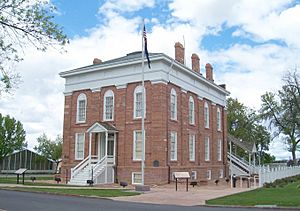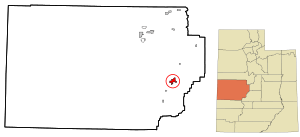Fillmore, Utah facts for kids
Quick facts for kids
Fillmore, Utah
|
|
|---|---|

Utah Territorial Statehouse
|
|

Location in Millard County and the state of Utah
|
|
| Country | |
| State | |
| County | Millard |
| Founded | 1851 |
| Named for | Millard Fillmore |
| Area | |
| • Total | 6.97 sq mi (18.04 km2) |
| • Land | 6.97 sq mi (18.04 km2) |
| • Water | 0.00 sq mi (0.00 km2) |
| Elevation | 5,135 ft (1,565 m) |
| Population
(2010)
|
|
| • Total | 2,435 |
| • Estimate
(2019)
|
2,650 |
| • Density | 380.36/sq mi (146.87/km2) |
| Time zone | UTC−7 (Mountain) |
| • Summer (DST) | UTC−6 (MDT) |
| ZIP code |
84631
|
| Area code(s) | 435 |
| FIPS code | 49-25510 |
| GNIS feature ID | 1441039 |
| Website | http://www.fillmorecity.org |
Fillmore is a city and the county seat of Millard County, Utah, United States. The population was 2,435 at the 2010 United States Census. It is named for the thirteenth US President Millard Fillmore, who was in office when Millard County was created by the Utah Territorial legislature.
Fillmore was the capital of the Utah Territory from 1851 to 1856, although the territorial legislature met in Fillmore only one term (1855). The original Utah Territorial Statehouse building still stands.
History
Fillmore, located near the geographic center of the territory, was originally built as the capital of Utah Territory. The Utah Territorial Legislature approved a plan to locate the capital in the Pahvant Valley. On October 28, 1851 Utah governor Brigham Young chose the specific site for Fillmore. Jesse W. Fox that same day surveyed the town.
Anson Call was the head of the colonizing company that shortly followed. Besides homes they built a grist mill and a saw mill. The capitol building was begun in 1852.
In the following years some disagreements developed with the Native Americans in the area, but Brigham Young sent Dimick B. Huntington to the area and he managed to negotiate a peace. The region was considered as a route, along the 38th parallel, for the transcontinental railroad. Captain John W. Gunnison, leading a military party surveying the region, was attacked by a band of Pahvants (Ute) west of Fillmore. In the resulting October 1853 massacre, Gunnison and seven of his men were killed. During the 1860s two forts, Fort Deseret and Cove Fort were constructed nearby as protection from Indian unrest.
In 1855 the territorial legislature met in Fillmore. However, in 1856, the legislature decided to move the Territorial Capital to the larger community of Salt Lake City.
Geography
Fillmore is located at 5,135 feet (1,565 m) in elevation. It lies in the Pahvant Valley, near the base of the Pahvant Mountain Range.
According to the United States Census Bureau, the city has a total area of 5.8 square miles (14.9 km²), all of it land.
| Climate data for Fillmore, Utah (1981–2010) | |||||||||||||
|---|---|---|---|---|---|---|---|---|---|---|---|---|---|
| Month | Jan | Feb | Mar | Apr | May | Jun | Jul | Aug | Sep | Oct | Nov | Dec | Year |
| Average high °F (°C) | 39.0 (3.9) |
44.9 (7.2) |
55.5 (13.1) |
63.9 (17.7) |
73.7 (23.2) |
83.4 (28.6) |
90.2 (32.3) |
87.9 (31.1) |
78.9 (26.1) |
65.8 (18.8) |
50.6 (10.3) |
38.9 (3.8) |
64.4 (18.0) |
| Average low °F (°C) | 20.1 (−6.6) |
24.1 (−4.4) |
31.2 (−0.4) |
36.9 (2.7) |
44.5 (6.9) |
52.6 (11.4) |
59.9 (15.5) |
59.2 (15.1) |
50.3 (10.2) |
38.9 (3.8) |
28.6 (−1.9) |
20.1 (−6.6) |
40.2 (4.6) |
| Average precipitation inches (mm) | 1.31 (33) |
1.47 (37) |
1.98 (50) |
1.85 (47) |
1.63 (41) |
0.89 (23) |
0.74 (19) |
0.79 (20) |
1.10 (28) |
1.81 (46) |
1.48 (38) |
1.50 (38) |
16.52 (420) |
| Average snowfall inches (cm) | 11.2 (28) |
12.9 (33) |
11.4 (29) |
6.8 (17) |
1.0 (2.5) |
0.1 (0.25) |
0.0 (0.0) |
0.0 (0.0) |
0.1 (0.25) |
2.2 (5.6) |
9.9 (25) |
13.8 (35) |
69.6 (177) |
| Source: NOAA | |||||||||||||
Demographics
| Historical population | |||
|---|---|---|---|
| Census | Pop. | %± | |
| 1860 | 715 | — | |
| 1870 | 905 | 26.6% | |
| 1880 | 987 | 9.1% | |
| 1890 | 838 | −15.1% | |
| 1900 | 1,037 | 23.7% | |
| 1910 | 1,191 | 14.9% | |
| 1920 | 1,490 | 25.1% | |
| 1930 | 1,374 | −7.8% | |
| 1940 | 1,785 | 29.9% | |
| 1950 | 1,890 | 5.9% | |
| 1960 | 1,602 | −15.2% | |
| 1970 | 1,411 | −11.9% | |
| 1980 | 2,083 | 47.6% | |
| 1990 | 1,956 | −6.1% | |
| 2000 | 2,253 | 15.2% | |
| 2010 | 2,435 | 8.1% | |
| 2019 (est.) | 2,650 | 8.8% | |
| US Decennial Census | |||
In 1853, 304 people were recorded as belonging in the LDS Church congregation when John A. Ray replaced Anson Call as the leader of the Mormons in Fillmore. In 1880, the larger population was divided into two LDS congregations ("wards"). In November 1882, the two congregations were joined again. In 1920, the congregation was again divided. In 1930 Fillmore had a population of 1374.
2010 census
As of the 2010 census Fillmore had a population of 2,435. The ethnic and racial make-up of the population was 78.7% non-Hispanic white, 1.1% Native American, 1.6% Asian, 0.1% Native Hawaiian, 2.3% reporting two or more races and 17.2% Hispanic or Latino.
Notable people
- Albert R. Lyman, writer
- Sam Melville, actor
- Culbert Olson, 29th Governor of California
- Clarence Robison, Olympian
- Arnold Williams, 21st Governor of Idaho
- Shayne Smith, stand-up comedian
See also
 In Spanish: Fillmore (Utah) para niños
In Spanish: Fillmore (Utah) para niños



